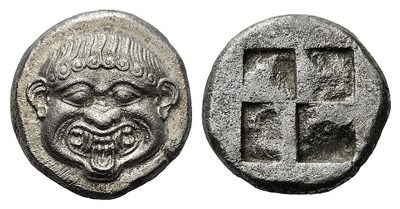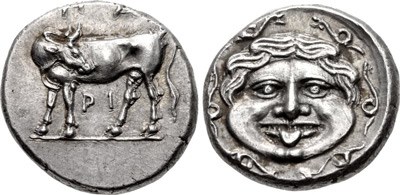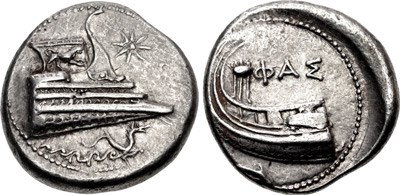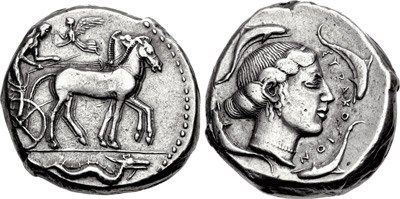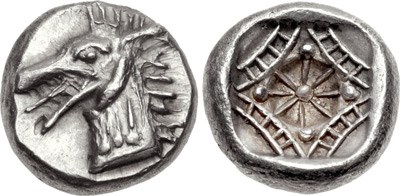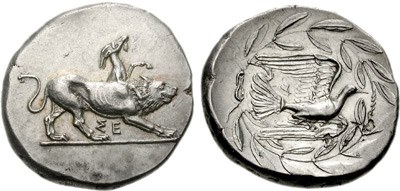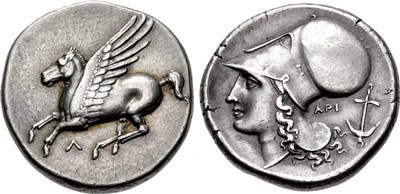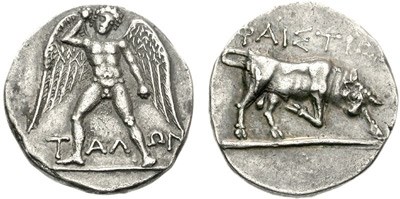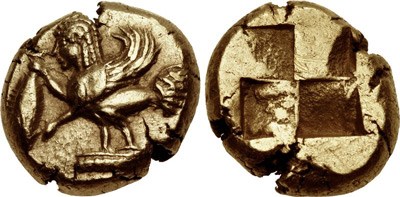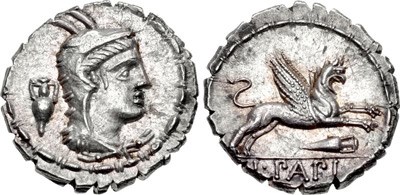NGC Ancients: Mythological Creatures on Ancient Coins
Posted on 1/12/2016
Among the most unusual things to appear on ancient Greek coins were monsters that more often are described as mythological creatures. To people of the modern world, these creatures are bizarre and fanciful; we wonder who could have believed that such creatures existed. But to the ancient Greeks they were familiar, and they played a meaningful role in their reckoning of the world. In this column we’ll discuss a few of these creatures.
Medusa. This terrifying creature was one of three sisters, known as Gorgons, who appeared with wings, snakes for hair, and expressions that bore sharp fangs and a tongue. Mortals were in grave danger, as merely looking at them would result in being turned to stone. While ghastly, the image of Medusa also had protective qualities, with the hero Perseus (who decapitated Medusa) using her head as a weapon against his enemies. He later bestowed the head of Medusa to the goddess Athena, who adorned her armor with it as a protective device.
Medusa often appears on ancient coins of the Mediterranean world. Below are three examples:
The scowling Medusa is engraved in high relief on this silver stater of Neapolis in Macedon, struck early in the 5th Century B.C.
Snakes outline the image of Medusa on this silver hemidrachm struck at the city of Parium in Mysia sometime in the 4th Century B.C.
Even the most powerful of Greek kings sought the protection of Medusa. This bronze half-unit of the Macedonian King Alexander III ‘the Great’ (336-323 B.C.) portrays the Medusa head on a shield. The reverse shows a crested helmet.
Ketos.The sea monster known as a ketos appears on a surprising number of ancient coins, including some important issues. When literally translated from Greek, “ketos” means “sea monster” and later in the Bible “large fish.” According to ancient myth, one ketos was said to reside near the mouth of the Nile River, and another in the Hellespont, near Troy.
Beyond its prominence in myth (a ketos, for example, was slain by Perseus and by Heracles), the very idea of a lurking ketos would have concerned any superstitious mariner. Sea travel in the ancient world was of great importance, and it was far more dangerous than it is in modern times. Three coins depicting ketos are shown below:
This silver stater of the 4th Century B.C., from Phaselis in Lycia, shows a ketos over waves beneath the prow of a galley. The reverse shows the stern of a galley.
One of the most significant coinages of the Greek world was the silver tetradrachm of Syracuse, Sicily. This one of the 460s B.C. shows ketos beneath a chariot, and on the reverse the head of the nymph Arethusa.
The fearsome head of a ketos appears on this silver tetrobol from the city of Cindya in Caria. It was issued c.510-480 B.C., and shows on its reverse a most intriguing geometric pattern.
Many of the most familiar Greek monsters are hybrids that combine body parts of various living creatures. In most cases, these beasts did not represent an existing fear, but the triumph of heroes in familiar myths. We’ll discuss a few of these creatures below.
Chimera. One of the strangest of the hybrid creatures is the Chimera, which most prominently appears on coins of Sicyon, a city near Corinth in central Greece. It was significant to this region because the hero Bellerophon, who with the help of the mythological winged horse Pegasus killed the fire-breathing Chimera, was a hero of Corinth.
On this silver stater of Sicyon from the late 5th Century B.C., the snake-headed tail and the goat forepart are attached to the lion body of the Chimera.
Pegasus. Perhaps the most recognizable of all ancient mythological creatures is Pegasus, the winged horse, who had aided Bellerophon. It appears above on a silver stater of the Corinthian colony Leucas. Issued there c.320-280 B.C., it pairs the creature with the goddess Athena.
Finally, on this bronze struck at Corinth early in the 2nd Century A.D., the whole myth is brought together: the reverse shows Bellerophon riding Pegasus, ready to hurl his spear at the chimera.
The ancient Greeks applied wings to many animals other than the horse. In fact, they seem to have found great pleasure in creating new ‘winged’ creatures, for they added wings to many things, including people, dogs, bulls, goats, boars, lions and stags, as well as to objects, such as hats, shoes, helmets, ships, chariots, wands (the caduceus) and thunderbolts. Three examples are pictured below.
Talus. The winged creature Talus, prepares to throw a stone on the obverse of this silver stater of Phaestus on Crete, struck early in the 3rd Century B.C.
Harpy. This mythological creature, on this electrum hecte of c.550-500 B.C., stands on a pedestal and holds a tunny (tuna) fish.
Griffin. Yet another familiar mythological creature, the griffin, appears on this serrated denarius of the Roman Republic, struck in 79 B.C. by the moneyer L. Papius. The obverse portrays the goddess Juno Sospita.
Interested in reading more articles on Ancient coins? Click here
Images courtesy of Classical Numismatic Group
Stay Informed
Want news like this delivered to your inbox once a month? Subscribe to the free NGC eNewsletter today!
